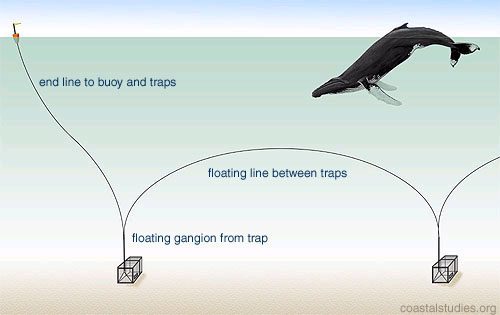Lobster Pot Diagram

Lobstering, in New England, provides a livelihood for thousands of families. Lobster pots, or traps have been modified over time but, the basic principle remains the same: lobster are lured up a mesh ramp by a bag of bait and fall into a compartment.
A series of pots may be strung together with synthetic lines and marked by buoys with an end line for locating and hauling in the gear. In many areas floating lines and gangions (the line that connects the trap to the end line) are used to keep the set from snagging on rocks while hauling in. Typically, a five foot, floating gangion and connecting lines create an arc that rises 15-20 feet into the water column and stretches 80-90 feet between traps. In different regions, a similar set up (collectively called pot fisheries) can be modified to target many different species, including crab or hagfish.
Gear modifications, based upon documentation of entanglements, to reduce potential by-catch of whales have included: reducing the end lines to one (in the past, buoys often marked both ends of the set); reducing knots on lines that may snag on whale baleen; replacing floating lines with neutrally buoyant or sinking line; creating weak links that pull apart at certain weight pressures; and seasonal or dynamic area management closures where and when whales and gear coincide.

Our Work
Humpback Whale Research
Right Whale Research
Marine Animal Entanglement Response
Marine Geology Department
Water Quality Monitoring Program
Marine Fisheries Research
Seal Research
Shark Research
Marine Education
Interdisciplinary
Marine Debris and Plastics Program
Marine Policy Initiative
Cape Cod Climate Change Collaborative
Publications

